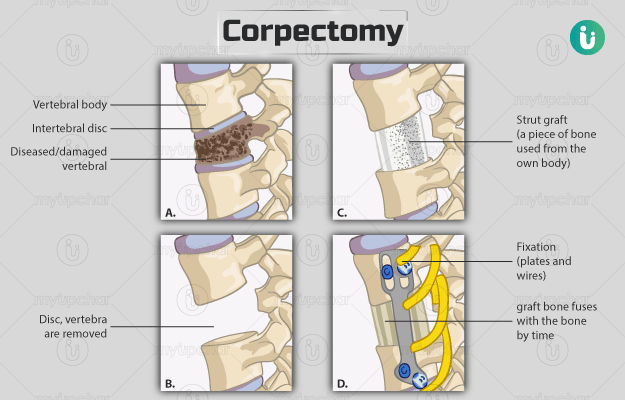Summary
Corpectomy is a surgery that is done to remove a damaged vertebral body (spine bone) and the discs between damaged vertebrae which are causing problems in the spine. The procedure can be performed in the cervical, thoracic, or lumbar regions of the spine. Before the surgery, your surgeon may order a few diagnostic tests to check your overall health. Tell your doctor if you are taking any medicines, have allergies or are pregnant. After the surgery, you must take care of your spine and avoid bending for a while. A follow up appointment will be scheduled a four to six weeks after the procedure to check your recovery.
- What is corpectomy?
- Why is corpectomy recommended?
- Who can and cannot get corpectomy?
- What preparations are needed before corpectomy?
- How is corpectomy done?
- How to care for yourself after corpectomy?
- What are the possible complications/risks of corpectomy?
- When to follow up with your doctor after a corpectomy?
What is corpectomy?
The spine or vertebral column is a bony structure in the back that supports the body and keeps it upright. It is made of 26 bones called vertebrae with intervertebral discs placed between them, and the spinal cord passing through the hollow middle of the vertebral column. The vertebral column starts from the base of the skull and ends at the pelvis. It is divided into four parts, cervical (neck), thoracic (upper and mid-back), lumbar (lower back), and sacral (base of the spine) regions.
Corpectomy can be done in the cervical, thoracic, or lumbar regions of your spine to remove the damaged vertebrae and intervertebral discs that press upon the spinal cord and nerves. The procedure can help relieve pain and other symptoms caused by the damaged vertebrae.
The damaged part is replaced with an implant, usually a bone graft or synthetic cage to rebuild the spine. The surgeon may also insert spine-stabilising material above and below the treated area to give it support and stability.
Why is corpectomy recommended?
Your healthcare practitioner may recommend this surgery in the following conditions related to vertebrae damage:
- Ossification (a condition in which a flexible body part becomes bone-like) of the posterior longitudinal ligament (that stabilises the spine) in people with kyphosis (an abnormally curved spine)
- Chronic instability of the spine
- Tumour
- Nerve compression around or behind the vertebral body
- Vertebral osteomyelitis (a bone infection) that causes the vertebral body to collapse.
- Pseudoarthrosis
- Spinal deformity due to scoliosis (sideways curvature of the spine)
You may experience the following signs if you have any spine problem:
- Difficulty walking
- Loss of bowel or bladder control
- Weakness in the upper and lower limbs caused by advanced neurologic deficit
- Damage to coordinated movements of the hands such as typing
- Severe pain
Who can and cannot get corpectomy?
The following factors need to be considered before performing a corpectomy:
- A person’s age
- Pre-existing medical conditions in a person
- The type of tumour affecting the spine
- Bone quality
What preparations are needed before corpectomy?
You will need the following preparation before this surgery:
- Your doctor will perform a physical examination and order the following tests:
- Stress test (in case of cardiac history)
- Electrocardiogram
- Chest X-ray
- Complete blood count
- You must inform your doctor about all your medications (current and previous). This includes blood thinners (like aspirin), over-the-counter medicines, and supplements.
- Also tell the doctor if you have any history of an allergic reaction to any medicines, latex, or food.
- If you have diabetes or any bleeding problems, ensure that your doctor knows about it.
- Using nicotine may cause a problem in recovery and bone fusion. Hence, the doctor may ask you to quit smoking for a month. Read more: Effects of smoking on health
- Make your doctor aware if you are or think you are pregnant before undergoing any examination like an X-ray for this surgery.
- Your doctor will ask you to stop drinking or eating anything from midnight before the procedure.
- You need to sign a consent form (to grant your approval) before the procedure.
On the day of the surgery:
- You must not wear makeup, nail paint, contact lenses, dentures, or jewellery.
- The doctor may ask you to not take medicines such as those for diabetes or hypertension on the morning of your operation.
How is corpectomy done?
On the day of surgery, the following procedure will be followed:
- You will have to wear special socks (to improve circulation) during and after the procedure.
- You will be given general anaesthesia (a medicine that will keep you asleep during the surgery).
- A Foley catheter will be placed in your bladder. The catheter will keep emptying your bladder during the procedure.
Generally, thoracic and cervical corpectomies are performed from the anterior (front) approach. However, the access to the vertebra may be from the front or the back (posterior) depending on the nature of the problem. In conditions like compression or disc problems, the anterior approach is taken while a fusion procedure is generally done from the posterior approach.
The procedure for orpectomy is as follows:
- The surgeon will make an opening at the front of your neck and move aside your muscles and other tissues to reach your spinal column.
- He/she will remove the affected vertebral body, along with the surrounding discs. This is known as decompression and helps alleviate pressure on the nerves and spinal cord.
- Next, the surgeon will perform spinal fusion to provide stability and strength to your spine.
- During spinal fusion, the surgeon wil use implants to fill up the space created after removal of the vertebral body and discs. These implants can be a strut graft (a piece of bone used from your own body) or cage (artificially synthesised using man-made bones, titanium, or ceramic). It is fixed in place in the spinal column using titanium screws and plates. The graft bone fuses with the bone already present in the long term, ensuring stability of the spine.
- For keeping the spine stable and encouraging better fusion, the surheon may use instruments such as plates and wires. This process is called fixation.
- Finally, he/she will close the opening with stitches and place a dressing on the area.
You will have a hospital stay of five to seven days after the procedure. However, this would depend on your overall condition. Once the surgery is complete, you will be moved to the recovery room and can expect the following:
- You will be given painkillers through a catheter placed in a vein in your arm. A drainage tube will be placed at the surgical site to remove excess fluids.Both the catheter and drainage tube will be removed after the surgery, usually the next day.
- The physiotherapist will teach you some exercises to regain your strength after the surgery.
- A nurse will help you walk (soon as you can) after the surgery. This will help improve your health and reduce the chances of blood clotting in your legs.
- You may need a back brace for comfort after thoracic surgery.
How to care for yourself after corpectomy?
You may need to take the following care at home:
- Diet:
- Initially, you will be on a soft food diet for the first two weeks. You can eat, cooked vegetables, or pudding and drink protein shakes.
- Avoid eating tough meats, nuts, and crunchy food items.
- Bathing or showering: You may be allowed to take a shower as usual after the surgery. However, avoid wetting the wound area. To prevent this, you can use waterproof dressing.
- Activities:
- You may be able to go to work eight to 12 weeks after the surgery and resume driving two to three weeks after the procedure. However, your doctor may suggest you to start with short drives (say for about 30 to 45 minutes).
- Avoid lifting, pushing, or pulling heavy objects.
- Walking at a slow pace for at least 30 minutes a day may help you in recovery.
- Make sure to keep your spine straight and avoid bending and twisting.
- Your doctor will prescribe pain medicines to help you relax after the surgery.
- You may be advised to wear a neck collar or back support to support your neck or back muscles until they heal enough. However, remove the support while eating, bathing, and sleeping.
When to see the doctor?
You should call or visit your surgeon if you experience the following symptoms:
- A fever of 101.3°F (38.5°C) or more.
- Extreme pain that is different from the usual pain.
- Sudden loss of control over the bladder and bowels.
- Persistent and sudden numbness or weakness.
- Swelling, redness, and oozing of any liquid at the surgical site.
- Headaches that remain even after taking painkillers.
What are the possible complications/risks of corpectomy?
Some complications and risks associated with corpectomy include:
- Complications related to anaesthesia
- Graft-related extrusion, haematoma (bleeding under the skin), and hernia
- Infection at the surgical graft site
- Paralysis of shoulders, arms, or biceps
- Nerve injury at the larynx (voice box)
- Difficulty in swallowing
- Tear in the dura mater of the brain with leakage of cerebrospinal fluid
- Haematoma at the surgery site
When to follow up with your doctor after a corpectomy?
Your doctor will schedule a follow-up appointment for four to six weeks after the surgery. During this visit, he/she will take x-rays to assess healing of your bones.
Disclaimer: The above information is provided purely from an educational point of view and is in no way a substitute for medical advice by a qualified doctor.
Surgery Cost In Your City
References
- Gupta MC, Devlin VJ, GogiaJS. Procedures for decompression of spinal cord and nerve roots. In: Devlin VJ. Spine Secrets Plus, 2nd ed. Elsevier Mosby; 2012. p. 165.
- Cleveland Clinic [Internet]. Ohio. US; Spine Structure and Function
- Waxenbaum JA, Reddy V, Williams C, et al. Anatomy, Back, Lumbar Vertebrae. [Updated 2020 Aug 10]. In: StatPearls [Internet]. Treasure Island (FL): StatPearls Publishing; 2020 Jan
- The Spine Hospital: The Neurological Institute of New York [Internet]. Department of Neurological Surgery. Columbia University. US; Thoracic Corpectomy
- Guy's and St. Thomas' Hospital: NHS Foundation Trust [Internet]. National Health Service. UK; Anterior Cervical Surgery
- Johns Hopkins Medicine [Internet]. The Johns Hopkins University, The Johns Hopkins Hospital, and Johns Hopkins Health System; The Road to Recovery After Cervical Spine Surgery
- Brighton and Sussex University Hospitals [Internet]. NHS Foundation Trust. National Health Service. US; Information and Guidance for Patients following Lumbar spinal surgery
- Sarkar S, Nair BR, Rajshekhar V. Complications following central corpectomy in 468 consecutive patients with degenerative cervical spine disease. Neurosurg Focus. 2016;40(6):E10. PMID: 27246480.















